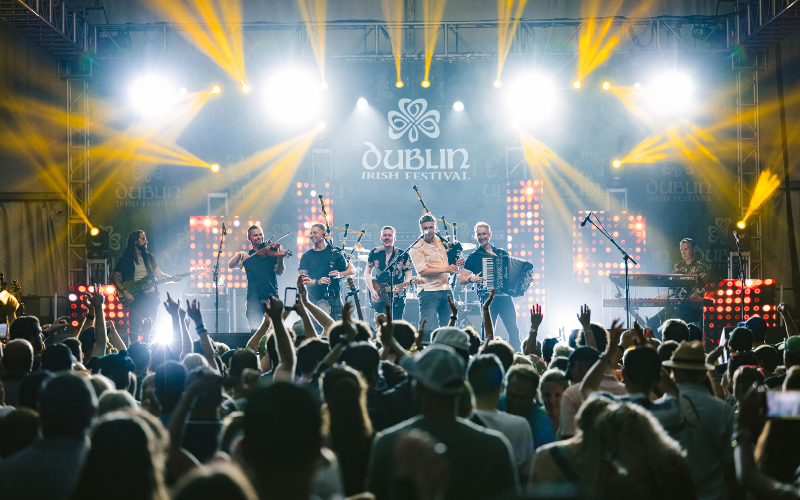I dared journey into the dark depths of haunted Dublin a few nights ago, and have finally gathered the wits to tell the tale. The Gravedigger Ghost Tour, a spooky interactive experience, took us through the old streets of Dublin on a haunted bus with a few deathly stops along the way.
But we were in safe hands, albeit dead hands: our tour guide was a ghoulish young man who died centuries ago as a victim of the Black Death, fully clad in ragged medieval garb and gruesome makeup. The informative and hilarious two-hour tour shared some incredible, must-hear stories of historical Dublin’s spooky side - gory tales of murder, torture, ghosts and whodunnits - all of which can of course be vouched for by various Dublin locals. And to ease our nerves, we ended with a quick stop at the famed Gravedigger’s Pub alongside Glasnevin Cemetery, which boasts one of Ireland’s finest pints of Guinness.
A simple walk through the bottom of the double-decker bus set the stage. A dark passageway covered in black curtains, scream masks, eerie blasts of air, a loud recording of blood-curdling screams, and handlebars covered in fake bones had me regretting the trip almost immediately. We waited patiently in our seats at the top level to be startled by our guide, a brilliant actor who’d clearly been practicing his maniacal laughter and scare tactics, who came equipped with a Ouija Board to beckon lost souls with more stories to tell.
At our first stop, our guide unlocked a large chained gate into the courtyard of Saint Audoen’s Church, “The Black Dog Jail,” standing behind Christ Church Cathedral. Back in the day of the Plague, the jail was aptly nicknamed “Hell.” There we learned the story of Dolocher: a tale similar to that of Jack the Ripper, but much stranger indeed, as it involves a murderous, black pig.
As the legend goes, after the murder of a woman in Dublin’s Liberties, a man named Olocher was tried and sentenced to death. On the night before his hanging, he took his own life in his cell - where we’d been standing on the tour - by slicing his neck open. A few days later, a sentry who’d been standing guard near the cell was found on the ground, having been badly mauled. He’d heard a strange sound, that of a pig, coming from Olocher’s cell, and the next thing he knew he was being attacked by a massive, demonic half-man, half-pig.
Read More: The Dolocher: The dark tale of Dublin's Jack the Ripper
Dublin’s inhabitants were terrified after this account, as each following night, women near the Liberties were being attacked and killed by this demon pig. The city was in a state of mayhem, and even went so far as to round up all the pigs they could find and kill them, in attempt to rid the city of the murderer. They were quite certain that the monster was a reincarnation of Olocher himself - so its nickname became “The Olocher,” which was then shortened by the Dublin accent to “Dolocher.”
By the end of Dolocher’s murders, a blacksmith, who was wearing a cloak borrowed from a pub owner’s wife, had been walking home one rainy night. Dolocher saw him as a vulnerable woman and attacked, but the blacksmith, who had some of his tools under the cloak, threw the demonic pig to the ground, stabbed him, and received help from passersby to remove the man’s mask and bring him to justice.
After we all stood stunned listening to the guide’s interactive telling of the tale, a man in a pig’s mask came running out squealing, and scared us all half to death.
Our next stop was at Kilmainham Jail, and the site of the Bully’s Acre cemetery, where we met another brilliant actor who’d assumed the identity of a very energetic and hilarious former inmate, equipped with a few tales of his own about certain ghosts that are thought to haunt the jail today. It’s no surprise that Kilmainham is notorious for being haunted, as most inmates were there waiting to be executed.
One such inmate was 1916 Easter Rising leader Joseph Plunkett, who joined his wife Grace Gifford in holy matrimony just three hours before his execution. Grace’s ghost is thought to haunt Kilmainham Jail; a few tourists have reported seeing her figure appear in photographs of Plunkett’s cell after the photos have been developed.
Kilmainham Gaol is well known for its eerie activity, ghost sightings, strange sounds and footsteps on empty stairwells, as well as the fierce drop in temperature when approaching the Stonebreaker’s Yard, where many men were executed by firing squad, including the 1916 leaders.
We learned about the author Charles Townsend, who stayed in the jail while researching for a book about its history. He experienced a truly terrifying ghostly commotion while trying to get a night’s rest: his bed became suddenly surrounded by an overwhelming sense of death, the lights flickered, his belongings fell and shattered, and he heard intense, blood-curdling screams for a few long moments before it all became very quiet. He hastily left the jail without looking back (leaving behind a wet patch on his bed, according to our guide). Another notable incident includes a religious painter who’d been repainting the dungeon: he recalls being pinned to a wall by an overpowering gust of wind, which he tried fighting for a few minutes before it stopped and he was able to break free, never to return to finish the job.
We began and ended the tour at Trinity College Dublin, which itself has quite the array of gruesome stories. The renowned university has a very dark past, and was even used as a sick hall for people struck with the Plague.
Enter the Burke-Hare duo: William Burke and William Hare, who made a lucrative living out of selling corpses to TCD medical students, which they’d use as cadavers for anatomy research and experiments. The duo began as grave robbers, selling a body for a mere 3 pounds each. But when they realized the demand, they upped their prices. After a time, their work became much, much darker, as they turned to cold blooded murder as a means of snatching bodies for cash.
Hundreds of thousands of bones were found in a pit underneath TCD’s Berkeley Library, proved to be the remains of the victims/cadavers. Strangely, the bones of a camel were found as well: as the story goes, a traveling circus had visited Dublin, and the TCD medical students, out of anatomical curiosity, stole their camel, practiced experiments on it, and buried it with the rest of the corpses.
Another eerie, true story of murder out of TCD is that of the college professor Edward Ford in 1734, killed by some of his students. Ford was known as the “Strange Scholar,” and was highly disliked by students as he was known to meddle in their affairs. He had been taking up residence in The Rubrics, TCD’s oldest building. On one evening, a group of drunken students took to The Rubrics and threw bottles and stones at Ford’s window. In retaliation, the Strange Scholar went to the window and shot at the students with a musket. The outraged students ran away, to return with muskets of their own. They provoked him from the window once again, and when he opened the window to admonish them, they fired shots into his head and chest, ultimately killing him.
The ghost of Edward Ford is said to still roam the halls of The Rubrics today, searching for the students who took his life.
As we stood at the gates of Glasnevin Cemetery and listened to gruesome tales by the Kilmainham inmate, our guide emerged from the adjacent Kavanagh’s Pub, nicknamed the Gravedigger’s, with spooky green and red drinks to sip on as we listened to the tales.
The Gravedigger’s Pub has been owned by the same family - the Kavanaghs - since 1833, and much of its interior hasn’t changed for hundreds of years either. The historical pub is famed for having one of Ireland’s finest pints of Guinness, and also for a few familiar ghosts and apparitions that locals encounter quite regularly.
The story of its nickname is quite interesting, and opposite to what you might expect. During the Black Death, gravediggers were the only people not allowed inside the pub, as they’d been burying rotting bodies all day, and the owner didn’t want them spreading death and disease to the patrons. If you were a gravedigger, there was a hole in the wall of the pub through which you could stick your shovel. On your shovel would be a few coins. In return, the bartender would place a pint of plain (Guinness) on the shovel, and return it back to you, to enjoy outside.
One of the pub’s former bartenders has recalled witnessing a bottle of whiskey fly off the shelf past his head, too: with 1.5 million people buried in the neighboring cemetery, there’s no doubt that this pub lives up to its title as one of Dublin’s most haunted.
Talk about spooky: the sole child on our tour actually lost his tooth beside the cemetery as our guide told us about grave robbers who snatched teeth from corpses. An eerie tour indeed. If you want a scary, hilarious, and informative ride through this fair city’s haunted side, I suggest taking a ride on the Gravedigger Ghost Tour. You may lose your wits, but you’ll gain an enjoyably frightening evening.




Comments